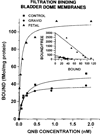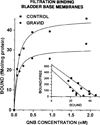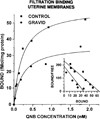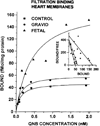Muscarinic receptor subtypes in normal, fetal, and gravid rabbit bladder, heart and uterus
- PMID: 8571837
- PMCID: PMC3280445
- DOI: 10.1007/978-1-4899-1585-6_30
Muscarinic receptor subtypes in normal, fetal, and gravid rabbit bladder, heart and uterus
Abstract
In the rabbit bladder, pregnancy has been shown to induce a significant decrease in both muscarinic receptor density and response to muscarinic stimulation. Neonatal rabbit bladders have a high muscarinic receptor density and contractile response to bethanechol stimulation. The bladders from 7 gravid rabbits, 7 age-matched virgin controls, and 32 fetal rabbits of 3 week gestation were studied. Compared to control tissue, filtration binding demonstrated receptor density to be 24.3% lower in gravid bladder dome, 41.2% lower in gravid bladder base, and 114.8% higher in fetal bladders. While total receptor density was not different from control in gravid heart, fetal hearts showed a 2.5 fold increased receptor density. There was also a 61% reduction in muscarinic receptor density in the gravid uterus. Immunoprecipitation assays using muscarinic receptor subtype specific antisera were used to measure the relative levels of m1, m2, m3 and m4 receptors. The m2 receptor was the predominant subtype in the bladder and uterus, and the only subtype detected in rabbit heart. The m3 receptor protein was also present, but in lower levels in the bladder and uterus. The m1 and m4 receptors were not detected in any of the tissues studied. Furthermore, the relative percent of each receptor did not statistically change for the gravid or fetal rabbit bladder, uterus, or heart, when compared to its control. Differences in the contractile response to cholinergic stimulation of the gravid bladder and uterus, and of the fetal bladder then, can be attributed to changes in muscarinic receptor density and not to changes in receptor subtype.
Figures




Similar articles
-
The effect of pregnancy and contractile activity on bladder muscarinic receptor subtypes.Neurourol Urodyn. 1999;18(5):511-20. doi: 10.1002/(sici)1520-6777(1999)18:5<511::aid-nau14>3.0.co;2-6. Neurourol Urodyn. 1999. PMID: 10494124 Free PMC article.
-
On the muscarinic receptors in the urinary bladder and the putative subclassification of muscarinic receptors.Acta Pharmacol Toxicol (Copenh). 1986;59 Suppl 1:1-45. Acta Pharmacol Toxicol (Copenh). 1986. PMID: 3524114 Review.
-
Effects of pregnancy on muscarinic receptor density and function in the rabbit urinary bladder.Pharmacology. 1991;43(2):69-77. doi: 10.1159/000138830. Pharmacology. 1991. PMID: 1775512
-
Hypertrophy changes the muscarinic receptor subtype mediating bladder contraction from M3 toward M2.Am J Physiol Regul Integr Comp Physiol. 2003 Sep;285(3):R701-8. doi: 10.1152/ajpregu.00009.2003. Epub 2003 May 22. Am J Physiol Regul Integr Comp Physiol. 2003. PMID: 12763741 Free PMC article.
-
Muscarinic receptor subtypes modulating smooth muscle contractility in the urinary bladder.Life Sci. 1999;64(6-7):419-28. doi: 10.1016/s0024-3205(98)00581-5. Life Sci. 1999. PMID: 10069505 Review.
Cited by
-
M2 muscarinic receptor contributes to contraction of the denervated rat urinary bladder.Am J Physiol. 1998 Nov;275(5):R1654-60. doi: 10.1152/ajpregu.1998.275.5.R1654. Am J Physiol. 1998. PMID: 9791087 Free PMC article.
-
Functional M3 muscarinic acetylcholine receptors in mammalian hearts.Br J Pharmacol. 2004 Jun;142(3):395-408. doi: 10.1038/sj.bjp.0705787. Epub 2004 May 17. Br J Pharmacol. 2004. PMID: 15148264 Free PMC article. Review.
-
Muscarinic receptor expression and receptor-mediated detrusor contraction: comparison of juvenile and adult porcine tissue.Pflugers Arch. 2008 May;456(2):349-58. doi: 10.1007/s00424-007-0407-z. Epub 2007 Dec 21. Pflugers Arch. 2008. PMID: 18157728
References
-
- Zderic SA, Plazak JE, Duckett JW, Snyder HM, Wein AA, Levin RM. Effect of pregnancy on rabbit urinary bladder physiology. Pharmacology. 1990;41:124. - PubMed
-
- Zderic SA, Duckett JW, Wein AA, Snyder HM, Levin RM. Developmental factors in the contractile response of the rabbit bladder to both autonomic and nonautonomic agents. Pharmacology. 1990;41:119. - PubMed
-
- Bonner TI, Buckley NJ, Young AC, Brann MR. Identification of a family of muscarinic acetylcholine receptor genes. Science. 1987;237:527. - PubMed
-
- Dorje F, Levey AF, Brann MR. Immunological detection of muscarinic receptor subtype proteins (m1–m5) in rabbit peripheral tissues. Mol. Pharmacol. 1991;40:459. - PubMed
-
- Luthin GR, Harkness J, Artymyshyn R, Wolfe B. Antibodies to synthetic peptide can be used to distinguish between muscarinic acetylcholine receptor binding sites in brain and heart. Mol. Pharm. 1988;34:327. - PubMed
Publication types
MeSH terms
Substances
Grants and funding
LinkOut - more resources
Full Text Sources
